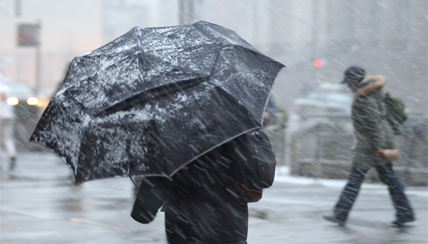Tips for Safe Winter Walking
Snow is beautiful but can make walking treacherous. Follow these simple hints to reduce the risk of falling and to help you safely maneuver on the snow and ice.
What to Wear
 Wear good shoes or boots with grip soles such as rubber or neoprene composite. Lace up shoes/boots to ensure good traction on less-than-ideal surfaces. Slick leather or plastic soles increase the risk of slipping.
Wear good shoes or boots with grip soles such as rubber or neoprene composite. Lace up shoes/boots to ensure good traction on less-than-ideal surfaces. Slick leather or plastic soles increase the risk of slipping.Wear a brightly colored scarf or hat or reflective gear, especially if you have to walk in the street. It’s important for motorists to see you. Remember gloves and sunglasses.
Dress to keep warm, but make sure you can hear what's going on around you.
How to Walk
Before walking for exercise in the cold or snowy weather, please check with your physician first.
When walking, curl your toes under and walk as flat-footed as possible.
Bend your knees a little and taking slower steps can greatly reduce your chances of falling.
Take short shuffling steps in very icy areas.
Walk with a friend or "buddy" when possible, for safety reasons.
What to Carry
Keep your full attention on walking.
Don’t walk with your hands in your pockets. You may need your arms for balance if you slip.
Don’t swing or carry heavy loads such as large boxes, cases, backpacks or purses that may cause you to lose your balance when walking.
How to Walk on Different Surfaces
Before getting out of your vehicle, look down at the surface. If it’s coated with ice you might want to park in a different place.
Use special care when entering or exiting vehicles; use the vehicle for support. Before standing, brace yourself with the vehicle door and seat back; this will give you some stability.
Use sidewalks or walkways instead of walking in the street. Walking in the street during winter conditions is not safe. If sidewalks and walkways are impassable and you have to walk in the street, walk against traffic and stay close to the curb.
Don't step on uneven surfaces. Avoid curbs with ice on them.
Test potentially slick areas by tapping your foot on them.
How to Walk Safely in Traffic
Snowdrifts can muffle the sounds of approaching motor vehicles. Hats and scarves that cover your ears can also block these sounds. Make sure you can hear what's going on around you.
Snow and ice may keep motorists from stopping at traffic signals or slowing down for pedestrians. Before you step off of the curb into the street, make sure that any approaching vehicles have come to a complete stop.
If you are looking to join a year-round walking program, check out the FREE Walk with a Doc program.
This information has been approved by the Safety Department at National Jewish Health (December 2016).
